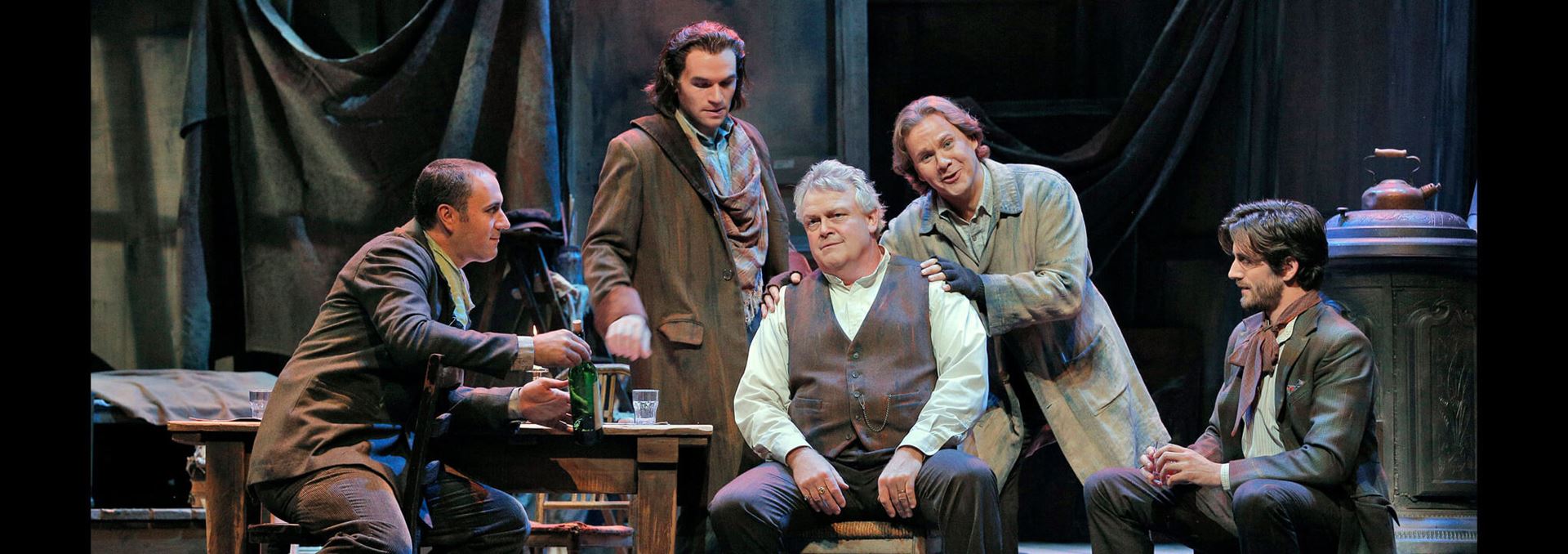
A Timeline of Opera History
Take a quick journey through the long and fascinating history of opera with this timeline of defining moments.
1600: Jacopo Peri’s opera Euridice, the earliest complete opera to survive, is performed
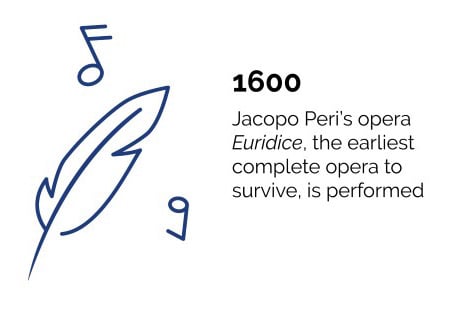
Opera originated in Italy around 1600, but its story began many years earlier with the birth of Jacopo Peri in 1561. During his time at the famed Medici court, Peri cultivated the idea of dramatic singing through his work with Florentine poets, musicians, and writers. Although these artists sought to recreate the simplicity and grandeur of ancient Greek drama through their work, they actually ended up creating an entirely new genre altogether: opera.
The birth of opera is typically associated with the 1600 premiere of Peri’s Euridice, the earliest complete opera to survive. However, Euridice is not actually the first opera ever written. That honor goes to Peri’s 1598 work Dafne, which was sadly lost to time. But both paved the way for operas still performed today, including Claudio Monteverdi's 1607 L'Orfeo, considered the first masterpiece of the genre.
1637: Teatro San Cassiano, the first public opera house, opens in Venice, Italy
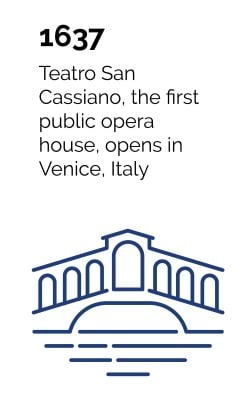
The first public opera house, Teatro San Cassiano, was inaugurated in Venice on May 6, 1637. Before the theater opened, operas were a spectacle only available to the aristocracy and the courts. But with the opening of Teatro San Cassiano, operas became available to anyone who could pay. This established the commercial practice of individual ticket sales and allowed opera to reach public audiences for the first time.
Of course, the audiences of the early 1600s were much smaller than they are today. Teatro San Cassiano contained 153 theater boxes spanning five tiers, which could seat approximately 400 people. By comparison, a modern opera house like the San Francisco Opera’s War Memorial Opera House can seat 3,006 viewers with 200 additional standing room spots!
1689: Henry Purcell’s Dido and Aeneas, the first major English opera, is performed
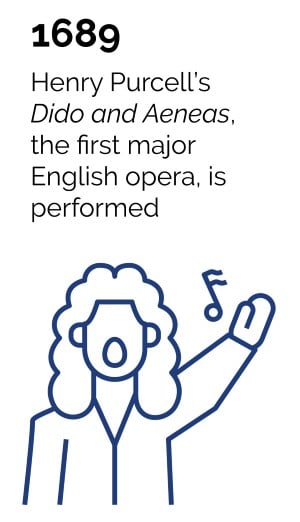 While opera may have been born in Florence, Italy is far from the only country that influenced its history. With Dido and Aeneas, England began to stake a major claim in the opera scene. Purcell’s work is an English Baroque opera based on Virgil’s telling of the legendary romance between Dido, the queen of Carthage, and Aeneas, a prince from Troy. Yet, despite its classical pedigree, Dido and Aeneas is thought to have premiered at an unlikely venue: Josias Priest’s Boarding School for Girls in Chelsea, London.
While opera may have been born in Florence, Italy is far from the only country that influenced its history. With Dido and Aeneas, England began to stake a major claim in the opera scene. Purcell’s work is an English Baroque opera based on Virgil’s telling of the legendary romance between Dido, the queen of Carthage, and Aeneas, a prince from Troy. Yet, despite its classical pedigree, Dido and Aeneas is thought to have premiered at an unlikely venue: Josias Priest’s Boarding School for Girls in Chelsea, London.
Through his work, Purcell helped pave the way for other icons of English opera, like German-born George Frideric Handel, who settled in London in 1712 and whose music owes a great debt to Purcell’s.
1762: Christoph Willibald Gluck’s reform opera Orpheus and Eurydice (Orfeo ed Euridice) has its premiere
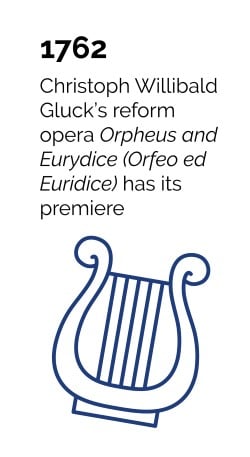
On October 5, 1762, Christoph Willibald Gluck’s Orpheus and Eurydice premiered at Vienna’s Burgtheater, kickstarting the beginning of the opera seria reformation. Like Peri and Monteverdi’s works before it, Gluck’s opera is based on the myth of Orpheus, a mortal man who enters the underworld to try to rescue his love, Eurydice. But despite being based on a classic tale, Orpheus and Eurydice was all about shaking things up.
Along with many of his contemporaries, Gluck believed that both opera seria and opera buffa—the two classic categories of opera—had strayed from the art form’s true purpose of capturing human passion, as the Greeks had done in their dramas. Gluck believed all elements of opera should be subservient to its plot and action, and he composed Orpheus and Eurydice following strict rules to achieve a “beautiful simplicity."
His arias contained fewer text repetitions, for instance, and his performers had fewer opportunities to show off with displays of vocal prowess. Additionally, he opted for a more syllabic setting of his opera's lyrics, pairing one note per syllable, not more. And rather than tacking on an unrelated overture to the start of his operas, Gluck made sure to match the overture’s sound to the theme of the storytelling, so that music and drama worked as one.
1786: Wolfgang Amadeus Mozart’s The Marriage of Figaro (Le nozze di Figaro) premieres
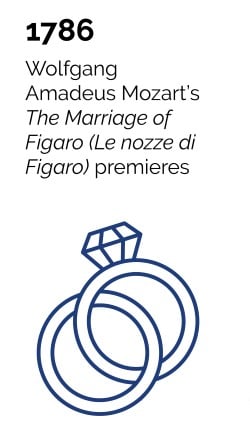
Choosing just one Wolfgang Amadeus Mozart opera to include on this timeline is a challenge, but 1786’s The Marriage of Figaro is hard to beat. Based on the 1778 French play La folle journée, ou le Mariage de Figaro by Pierre Beaumarchais, Mozart’s The Marriage of Figaro is set over a single, incredibly eventful day. The opera is chock-full of seduction, disguises, and lies, culminating in a successful double marriage. With so much going on, the opera’s subtitle, “A Day of Follies,” seems apt.
But The Marriage of Figaro is more than a frothy comedy. Considered by some to be a "perfect opera," it also functions as a biting social critique denouncing the excesses of the upper classes. In early drafts, writer Lorenzo Da Ponte even included an aria mocking the idea of inherited nobility.
Following rigorous censorship, The Marriage of Figaro finally premiered on May 1, 1786, at Vienna’s Burgtheater. It was a smash hit—one whose success would only be overshadowed in 1791 by Mozart’s The Magic Flute (Die Zauberflöte).
1816: Gioachino Rossini’s The Barber of Seville (Il barbiere di Siviglia) premieres
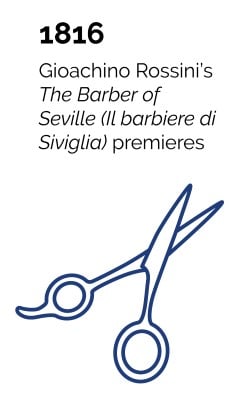
Although it premiered 30 years after Mozart’s The Marriage of Figaro, Gioachino Rossini’s The Barber of Seville is actually a kind of prequel. Both operas follow the adventures of Figaro, a witty jack-of-all-trades in the employ of a wealthy count. But The Barber of Seville is based on the first story in the trilogy of Figaro plays, while The Marriage of Figaro is based on the second.
The Barber of Seville is known for its many beautiful moments—particularly those that use a style called bel canto, literally translated as “beautiful singing.” In fact, Rossini is famous for embracing bel canto to maximize the individual qualities of each voice type. The rich, ornate vocal lines and compelling crescendos that Rossini harnessed so effectively led to the composer’s reputation as a master of the style.
1851: Giuseppe Verdi is established as the leading Italian opera composer of the period
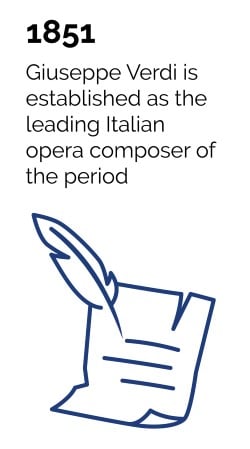
With his trio of back-to-back blockbuster operas—Rigoletto in 1851, Il Trovatore in 1853, and La Traviata in 1853—Giuseppe Verdi cemented himself as the “it composer” of the mid-to-late 19th-century Italian opera scene. Verdi was also a known supporter of Italy’s movement towards unification, called the Risorgimento.
These political beliefs are often visible in Verdi’s works through an ever-present streak of either overt or covert nationalism. One of the most prominent examples was his Il Trovatore, set at the end of a real civil war in Aragon. The opera asserts the view that bad things happen when internal fighting erupts within a nation. It was all part of a wave of nationalism echoed by other opera composers as well, particularly following Italy's unification in 1861.
1865: Richard Wagner’s Tristan and Isolde (Tristan und Isolde) premieres
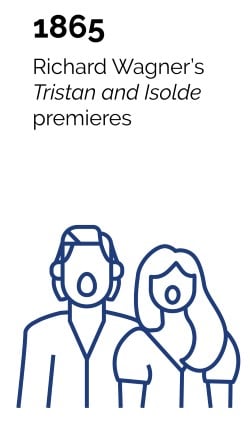
Richard Wagner captured the medieval love story between an Irish princess and a knight in the opera Tristan and Isolde (Tristan und Isolde), which debuted on June 10, 1865 at the Königliches Hoftheater und Nationaltheater in Munich. With its premiere, Tristan and Isolde marked the shift away from opera’s reliance on harmony and tonality to the dissonant style that laid the groundwork for classical 20th-century music.
There’s no denying that Wagner’s music is intense, but his beliefs about performance were often even more so. Wagner’s philosophy of total art, “gesamtkunstwerk,” stated that performance should constitute a complete unification of all art forms, in which all elements complement each other and work towards a common purpose.
Similar to Christoph Willibald Gluck before him, Wagner thought opera’s sensationalized singing, outrageous stage effects, and meaningless plots were beneath the ideal gesamtkunstwerk, so he strived to get away from them. The closest he came to achieving this paradigm was with his four-part masterpiece, the Ring cycle (Der Ring des Nibelungen), which premiered in full in 1876.
1896: Giacomo Puccini’s La Bohème premieres
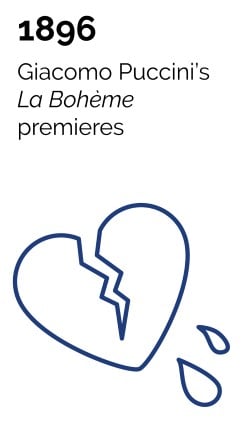
Giacomo Puccini’s La Bohème remains one of the most famous and popular operas of all time, inspiring other works across genres and mediums, including Jonathan Larson’s groundbreaking musical Rent. It tells the story of four struggling artists who find love and loss on the streets of Paris. Although La Bohème offers a tour of the French capital's bohemian haunts, Puccini himself had never been to Paris before writing the opera!
Despite that, La Bohème marked a high point in the realism, or “verismo,” trend in opera with its premiere on February 1,1896 at Turin’s Teatro Regio. With its focus on the lives of ordinary people, La Bohème continued a movement toward more relatable subject matter, in the same vein as earlier operas like Pietro Mascagni's Cavalleria Rusticana.
1905: Richard Strauss’ Salome premieres
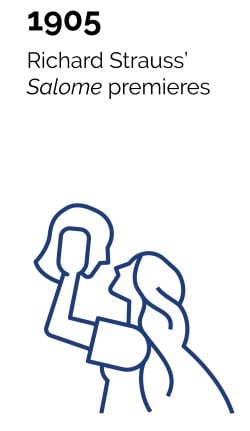
Richard Strauss based Salome on Oscar Wilde’s 1891 play of the same name. The opera follows Salome, stepdaughter to King Herod of the Jews, as she develops an obsession with Jochanaan, also known as John the Baptist. In exchange for a seductive dance, Salome demands that her stepfather deliver Jochanaan’s head on a platter. Once it is brought to her, she kisses the severed head. Salome’s behavior outrages Herod, who orders his soldiers to kill her.
Salome’s premiere at the Dresden Court Opera in Germany marked a move towards modernism in opera. The score contains dissonance and bitonality and calls for unique instruments—all concepts that signify Strauss was leaving behind older models of operatic music in his new compositions.
1935: George Gershwin’s Porgy and Bess premieres
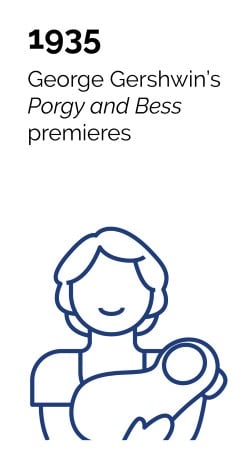
Set in the fictional Black neighborhood of Catfish Row in 1920s Charleston, South Carolina, George Gershwin’s Porgy and Bess tells the story of Porgy, a disabled beggar, and Bess, a woman trying to escape an abusive relationship. While the work initiated critical dialogue regarding desegregation on the stage, it also promulgated stereotypes of poverty, violence, and drug abuse in Black communities, making it a complicated work to reckon with. When Porgy and Bess premiered in Boston on September 30, 1935, it was met with mixed reviews, in part because of those stereotypes.
Today, we recognize that Porgy and Bess is not representative of the current movement to create more diverse and authentic cultural representation in the field of classical arts and musicals. At the time, Gershwin’s dramatic masterpiece was groundbreaking on both musical and social levels, yet today it manifests as an important historical artifact—an entertaining theatrical vehicle based on white people’s pejorative depictions of African American life. Whether seen as a work of appropriation or appreciation, this seminal work has cemented itself as a part of American musical folklore.
Notably, Gershwin also took an equity-minded step in the release of this opera, making it a contractual obligation that Black roles be played by Black actors—as opposed to white people in blackface, as some producers suggested.
While Gershwin—a white man and son of Russian-Jewish immigrants—won fame for his work, his Black contemporaries struggled against a segregationist society. It wasn't until March 31, 1949 that a major American opera company produced an opera by Black composer: Troubled Island by William Grant Still.
Sadly, the racism of the time was likely reflected in the reception of Troubled Island: While audiences applauded 22 curtain calls on opening night, critics largely slammed the opera. In fact, Howard Taubman, a writer and friend of Still’s, told him that the city’s critics held a meeting where they voted to pan the opera in order to stop the Black composer’s success. Shameful moments in our history like these are a powerful reminder of the importance of lifting up voices traditionally marginalized in opera.
1951: Gian Carlo Menotti’s Amahl and the Night Visitors, the first opera written for television, premieres
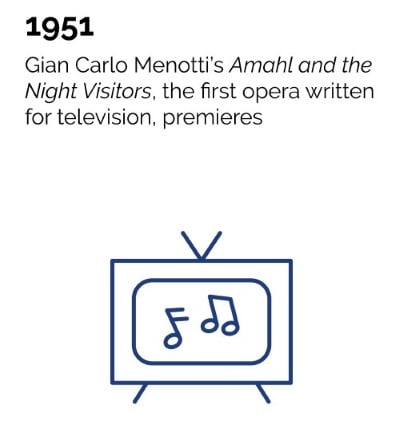
Gian Carlo Menotti’s TV opera Amahl and the Night Visitors retells the biblical story of the Three Kings, or Magi. In the opera, the Magi knock on the door of Amahl, a young boy who relies on a crutch to walk, and his mother. The two invite the Kings into their humble home but then attempt to rob them of their gold. Fortunately, the Magi find forgiveness in their hearts. They gift the gold to the mother and heal Amahl’s leg.
Amahl and the Night Visitors was commissioned by NBC and broadcast live on December 24, 1951, from Rockefeller Center in New York City. This production, and the general rise of TV, began to change all facets of opera—the makeup became more realistic and less fanciful, the casting became more critical and true. For example, Menotti insisted that Amahl be played by a boy, not a woman in a trouser role as was common for young male characters in opera.
Menotti’s opera also paved the way for more operas to be televised, like Leonard Bernstein’s opera Trouble in Tahiti, which premiered in 1952.
1976: Philip Glass’s Einstein on the Beach premieres
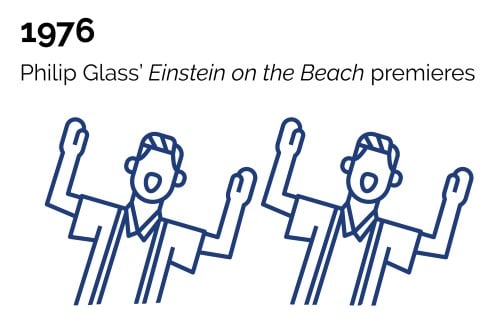
With Philip Glass, opera entered a brand-new era. The composer’s Einstein on the Beach is anything but conventional, stripping away some of the elements once considered essential to opera. For example, instead of using a traditional orchestra, Glass composed the work for synthesizers, woodwinds, and the voices of the Philip Glass Ensemble.
Even the structure of Einstein on the Beach defies convention. The opera consists of four acts, divided into small scenes called “knee plays” that incorporate a series of recurring images, poetry, and abstract dance sequences. Although the play implies we’ll see Einstein playing volleyball, Glass intended for audiences to construct personal connections with Einstein as a character and as a musical experience.
Since the release of Glass’s groundbreaking work, operas have continued to be largely experimental and focused on modern themes, stories, and people, as is evident through the work of minimalist composer John Adams. His operas Nixon in China and The Death of Klinghoffer put current events to music and show that there is just as much drama in the present as in the past. Adams continues to change the face of opera through his work, including Girls of the Golden West, a new opera that premiered at San Francisco Opera in 2017.
The Future: Yours to Define
Opera continues to grow and evolve, with new performers, musicians, writers, and composers redefining the medium every day. Innovators like Finland's Kaija Saariaho are increasingly blurring the line between electronic music and traditionally classical sounds. It's not uncommon to see a DJ in the orchestra pit—as composer Mason Bates has done with operas like The (R)evolution of Steve Jobs.
Opera is also expanding to tell a wider range of stories, from communities not historically represented in the art form. One recent example comes from Grammy winner Rhiannon Giddens and Michael Abels, composer for the Oscar-winning film Get Out. In 2022, they plan to premiere Omar, an opera about the Muslim scholar Omar Ibn Said, who was kidnapped from his home in modern-day Senegal and brought to Charleston as a slave. San Francisco Opera is a co-commissioner for the opera, which opens at Charleston’s Spoleto Festival USA.
What will the next great innovation in opera look like? The medium's future is yours to define.
Want to learn more about opera?
Check out our other blogs for more opera insights and learn more about San Francisco Opera’s current season on our On Stage page!

